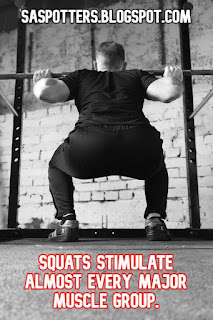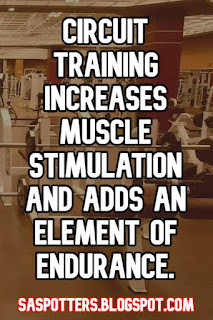This article is written by Rob Maxwell, M.A. Exercise Physiology, CSCS and ACSM CPT from www.fittothemax.net. Follow him on Twitter.
There are many different types of workout designs.
Some make sense. A few are designed by pros.
Some are on the opposite end of the spectrum. They aren't effective.
I’ve been in the personal training business for 25 years. I have learned that workout design is especially important to get results. I’ve also learned that as trainers we must also be time managers.
The workout we pick must fit into the schedule that we and the client have. Personal training sessions are typically 30, 45, or 60 minutes. Time must be used efficiently.
The push squat pull format
One of the workout structures that I like to use is a Push/Squat/Pull format.
It’s really what every workout is based around anyway. Let me explain.
The body only has so many main movements. Our body pushes, our body pulls, and our body squats.
This is an oversimplification but these main movements, when done correctly, work most of our body's musculature.
There are only so many major muscle groups of the body. There are over 650 muscles in the body, but the major muscle groups that move the body are far fewer.
The major muscle groups are the gluteals (butt), quadriceps (anterior upper thigh), hamstrings (posterior upper thigh), pectoralis major (anterior upper torso), latissimus dorsi/rhomboids (posterior upper torso), deltoids (shoulders), biceps (anterior upper arm), triceps (posterior upper arm), erector spinae (posterior lower torso), abdominals (anterior lower torso), and gastrocnemius/soleus (posterior lower leg).
The 11 major muscle groups
 |
| Stimulate each group effectively. |
Compound exercises versus isolation exercises
When designing a program, it is important to understand the difference between compound exercises and isolation exercises.
The difference between compound exercises and isolation exercises
Compound exercises use more than one joint and therefore more than one muscle group per exercise. Isolation exercises are exercises that only use one joint and therefore one muscle. The squat is a compound exercise. The leg extension is an isolation exercise.
A squat is a compound exercise because you bending both your hips and knees. You use your glutes, quads, and hamstrings. Compound exercises are more efficient. You train more than one muscle at the same time.
The leg extension isolates the quads, but doesn’t work the other upper thigh muscles like the hamstrings. Isolation exercises have their purpose - especially for body building.
When you are trying to get stronger and add muscle, and you are on a time budget, compound exercises are best.
 |
| Compounds exercises are the best. |
Muscle actions
Another thing to understand about exercise design is the actions of each muscle while we exercise.
When we do an exercise, our muscles either take on the role of the agonist, antagonist, stabilizer, and/or synergist.
The 4 different muscle actions
What is an agonist?
What is an antagonist?
What is a stabilizer?
What is a synergist?
Exercise selection for the push squat pull program
When we do a push/squat/pull program, the exercises need to be compound so that all of the major muscles can be activated.
Push exercises
When picking a push exercise, it can be a chest press of any type.
This may include the bench press, machine press, dumbbell chest press and/or push-up.
An overhead press motion is good as well, but it does not work the big pectoral muscles. The overhead press works the deltoids and triceps. It is a nice supplement to your main push exercises of choice.
Squat exercises
The squat exercise can be any version of a squat. It may be a standard squat, dead lift, split squat (lunge), and/or leg press.
This decision depends on what equipment you have and whether you have a spotter.
Pull exercises
The pull exercises can be a lat pull down, any version of rows, and/or pull-ups. They are all great compound exercises. A variety would is always best.
All of these exercises use stabilizers and synergistic muscles. That means that your arms, abs and other muscles will get enough stimulation as well.
Sets, reps and structure for the squat push pull routine
Do 3-6 sets of 8-15 reps of each exercise
Sets should be anywhere from 3 to 6 for each muscle group.
Naturally, this is just a range and there are many variables such as form, tempo, and load. But it does give us a good starting point.
The repetitions depend on your overall goals. I think that for most people, the best rep range is 8-15.
In this rep range you get strength, size and endurance.
You can simply do each exercise in straight sets of 3-6 per exercise. For most of my clients I prefer circuits.
Use circuit training to make your workout more efficient
The most efficient way to do a workout like this would be in the form of a circuit.
A circuit incorporates inactive rest. You rest one area while working another. Circuit means going from one exercise to the next with little to no rest.
A circuit also burns more calories because you keep moving. It is far more time efficient. It increases endurance on a whole new level.
There are two different ways that you can split up circuits.
Circuit training with 3 different exercises
Pick 3 compound exercises.
One should be a type of squat exercise. One should be from the push type of exercise. The other is a pull movement.
Keep the reps at 12.
Here is an example: Use the incline dumbbell press, Smith squat and pull down exercise.
Set the load for the heaviest weight you can do for 12 reps while keeping good form and completing all of your reps.
Move onto the second exercise as soon as you complete the first exercise. Once you have done all three exercises, you have done one set.
Do 3-6 of these sets.
Go up the next time by adding 5% to the load if you can complete all of your reps in good form.
Pyramid circuit training
You can also do a pyramid type set routine while doing this circuit.
An example would be 15 reps on the first set, 12 reps on your second set, 10 reps on your third set, 8 reps on your fourth set and 5 reps on your fifth set.
The structure of sets and reps can be varied.
Circuit training of 6 alternating exercises
Do two main circuits of 3 rounds of reps.
Each exercise gets 3 sets.
Here is an example of this.
In the first circuit, do 3 rounds of 12 reps of the following exercises:
- Machine Chest Press
- Dumbbell Squat
- Seated Machine Row
After that is complete you can take a 30 second break and set up for the second circuit.
In the second circuit do 3 sets each of:
- Bench Press
- Split Squat
- Pull Downs
This is a hard circuit.
When picking your pull exercise, you want to stay away from an exercise that would put strain on your lower back.
This is because you are already doing a squat in the circuit.
A row with the back supported would be better than a bent over row for back because your lower back is already tired from squats.
What about core exercises?
Too many people obsess over core exercises.
This means that the flat stomach that people desire does not come from doing abdominal exercises.
They come from losing weight by eating less.
I am not saying never train them. I am saying de-prioritize them.
I guarantee that you will get a great core work if you engage them in all of the above exercises.
I call it the 'no core, core' plan. I say it to my clients all the time.
If you brace your spine whenever you exercise (especially during squat and pull exercises) you will target the transverse abdominis (ab muscles) just like you would during a plank exercise.
This is the job of the ab muscles. By doing this you work the abs in the same natural way that they were meant to be stimulated.
Remember from above that your core muscles act like stabilizers. If you are mindful (focus on form) during your workout, they are engaged.
Warm up and cool down
Like with any good workout plan, begin this workout with a 5–10-minute warm-up.
A warm-up is not stretching. A warm-up is raising your core temperature through light cardio.
You will exercise more effectively when you warm up properly beforehand.
Make the warm-up exercise light cardio of whatever you like. Break a sweat and you know that you are warmed up.
It is also recommended that you do a warm-up set per each exercise.
Use about 50% of the load you are going to use for your sets and do 10 reps.
It is good to do specific warm-ups like this as well so that the body is ready to work the target muscles with intensity.
Cool down for 5 minutes after your workout doing light cardio again.
This allows your body to recover better for next time.
You will return your system to homeostasis and help move lactic acid (the byproduct of exercise that gives you a burning sensation in your muscles) out of the body.
You can do the push pull squat program anywhere
The Squat/Push/Pull program is one of my favorite routines.
It can be done anywhere.
If you are traveling and can find a gym with a few dumbbells, you can do it there.
You can simply do push-ups, body weight squats and rows if you don't have equipment.
A body weight option can always be done if you have the strength to do it - and it is the hardest of them all.
This would be a push-up (or dip), squat, and a pull-up version.
It’s a terrific way to cover the body, move fast and reach your goals.
I use a semblance of it with most clients I see on a regular basis.
We must be effective as trainers. To do that, we need to manage time.
This is one of the best ways that I’ve found to do so.
This article is written by Rob Maxwell, M.A. Exercise Physiology, CSCS and ACSM CPT from www.fittothemax.net. Follow him on Twitter.







Rob Maxwell is an excellent trainer, my first many years ago. We now live on opposite sides of the country or he would still be my trainer. I do follow him on line and get much education from his articles and the workouts he describes.
ReplyDeleteThank you so much for your feedback.
ReplyDeleteRob Maxwell has really shared some invaluable information. Thousands of people read his stuff here every day.
It looks like he really knows how to help people to improve their lives for the better, and I know for a fact that he knows what he is talking about.